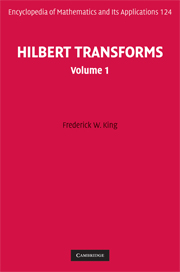Book contents
- Frontmatter
- Contents
- Preface
- List of symbols
- List of abbreviations
- 1 Introduction
- 2 Review of some background mathematics
- 3 Derivation of the Hilbert transform relations
- 4 Some basic properties of the Hilbert transform
- 5 Relationship between the Hilbert transform and some common transforms
- 6 The Hilbert transform of periodic functions
- 7 Inequalities for the Hilbert transform
- 8 Asymptotic behavior of the Hilbert transform
- 9 Hilbert transforms of some special functions
- 10 Hilbert transforms involving distributions
- 11 The finite Hilbert transform
- 12 Some singular integral equations
- 13 Discrete Hilbert transforms
- 14 Numerical evaluation of Hilbert transforms
- References
- Author index
- Subject index
Preface
Published online by Cambridge University Press: 04 May 2010
- Frontmatter
- Contents
- Preface
- List of symbols
- List of abbreviations
- 1 Introduction
- 2 Review of some background mathematics
- 3 Derivation of the Hilbert transform relations
- 4 Some basic properties of the Hilbert transform
- 5 Relationship between the Hilbert transform and some common transforms
- 6 The Hilbert transform of periodic functions
- 7 Inequalities for the Hilbert transform
- 8 Asymptotic behavior of the Hilbert transform
- 9 Hilbert transforms of some special functions
- 10 Hilbert transforms involving distributions
- 11 The finite Hilbert transform
- 12 Some singular integral equations
- 13 Discrete Hilbert transforms
- 14 Numerical evaluation of Hilbert transforms
- References
- Author index
- Subject index
Summary
My objective in this book is to present an elementary introduction to the theory of the Hilbert transform and a selection of applications where this transform is applied. The treatment is directed primarily at mathematically well prepared upper division undergraduates in physics and related sciences, as well as engineering, and first–year graduate students in these areas. Undergraduate students with a major in applied mathematics will find material of interest in this work.
I have attempted to make the treatment self–contained. To that end, I have collected a number of topics for review in Chapter 2. A reader with a good undergraduate mathematics background could possibly skip over much of this chapter. For others, it might serve as a highly condensed review of material used later in the text. The principal background mathematics assumed of the reader is a solid foundation in basic calculus, including introductory differential equations, a course in linear and abstract algebra, some exposure to operator theory basics, and an introductory knowledge of complex variables. Readers with a few deficiencies in these areas will find a number of recommendations for further reading at the end of Chapter 2. Some of the applications discussed require the reader to be familiar with basic electrodynamics.
- Type
- Chapter
- Information
- Hilbert Transforms , pp. xxi - xxivPublisher: Cambridge University PressPrint publication year: 2009

